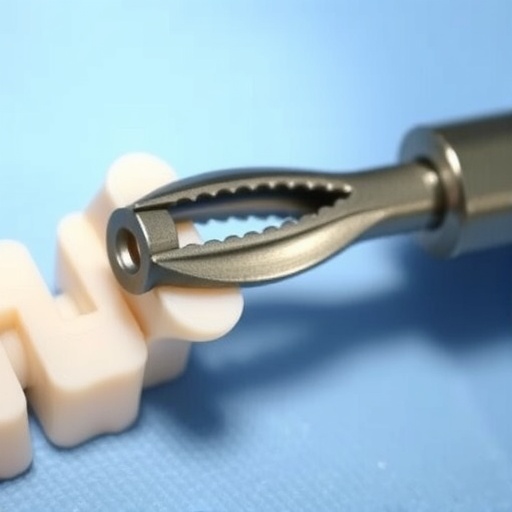In a groundbreaking study, researchers have advanced surgical techniques for treating osteonecrosis through the development of an innovative instrument known as the disposable eccentric curette. This device is specifically designed to enhance core decompression surgery, a popular method used to alleviate pressure in the bone and promote healing in cases of necrotic bone tissue. The need for advanced tools in this surgical domain is paramount, given the complexities associated with removing necrotic bone while preserving surrounding healthy tissue. With their cutting-edge design, this new curette is expected to revolutionize the approach to this challenging procedure.
Current approaches to core decompression surgery typically face limitations, particularly regarding the precision of bone removal. Traditional instruments can result in excessive damage to surrounding healthy areas, increasing the risk of complications and prolonging recovery times. The introduction of an eccentric curette addresses these concerns by offering a more controlled and targeted means of necrotic tissue removal. This advancement could lead to improved surgical outcomes and a more efficient healing process for patients suffering from conditions like avascular necrosis.
The eccentric curette’s design is a product of extensive biomechanical evaluation, ensuring that it not only meets the necessary surgical requirements but also enhances the overall efficacy of the procedure. Unlike conventional curettes, which often have a symmetrical design, this new device features an eccentric blade configuration. This unique shape allows the surgeon to approach the necrotic area from a more advantageous angle, thereby minimizing trauma to healthy surrounding tissues while effectively removing damaged bone.
In their comprehensive evaluation, the researchers conducted tests to assess the biomechanical properties of the new curette. These tests allowed them to analyze factors such as cutting efficiency, structural integrity under load, and the ability to navigate complex anatomical structures. Findings indicated that the disposable eccentric curette significantly outperformed traditional instruments in terms of both efficiency and precision. The results of these evaluations are crucial, as they provide the clinical validation necessary for adopting this instrument in surgical practice.
With the incorporation of advanced materials and ergonomic design principles, the disposable eccentric curette is not only effective but also user-friendly for surgeons. Its lightweight construction and intuitive handling can contribute to reduced fatigue during long surgical procedures, ultimately enhancing the overall efficiency of the operating room. Moreover, the disposable nature of the curette eliminates concerns about sterilization and cross-contamination, making it a safer option for both patients and medical staff.
Training and education are integral to the successful implementation of new surgical tools. As such, accompanying the introduction of the eccentric curette will be a series of educational programs aimed at ensuring that surgeons are adept at utilizing this innovative device. By providing comprehensive training and resources, the developers aim to facilitate the transition to this new approach, ensuring that it becomes a standard practice in core decompression surgeries.
The potential for widespread impact is significant, especially considering the prevalence of osteonecrosis and related conditions across diverse patient populations. By improving surgical techniques and outcomes, the eccentric curette could contribute to enhanced patient satisfaction and quality of life. This enhancement in surgical effectiveness may also lead to lower healthcare costs associated with complications or extended rehabilitation, representing a win-win scenario for both patients and healthcare providers.
Furthermore, the enthusiasm surrounding the disposable eccentric curette extends beyond clinical settings, as researchers aim to explore its applications in other surgical fields where precision bone removal is essential. Future studies may expand on this device’s versatility, paving the way for its use in various orthopedic surgeries, thereby broadening its impact in medical science.
In conclusion, the introduction of the disposable eccentric curette marks a significant milestone in the evolution of surgical techniques for necrotic bone removal. Through meticulous design and biomechanical evaluation, researchers have created a tool that promises to enhance precision, improve patient outcomes, and streamline surgical practices in core decompression surgery. Continuing to advance medical technology in this manner demonstrates a commitment to providing better solutions for complex medical challenges, ultimately fostering a new era of surgical excellence.
As this innovation gains traction, it represents not merely a tool but a paradigm shift in how orthopedic surgeons approach the intricate challenges associated with necrotic bone treatment. The road ahead looks promising, holding the potential for innovations that can significantly enhance patient care.
In anticipation of regulatory approval and clinical adoption, the research team hopes the eccentric curette will redefine surgical standards, translating its efficacy into tangible benefits for patients worldwide. Each advancement in surgical instruments opens the door to greater successes in patient recovery, driving home the importance of continued innovation in the medical field.
As surgeons prepare to embrace this modern tool, the future of core decompression surgery is poised for transformation, with the promise of improved techniques that align with the highest standards of care and precision in orthopedic surgery.
Subject of Research: Development and biomechanical evaluation of a disposable eccentric curette for core decompression surgery.
Article Title: Design and Biomechanical Evaluation of a Disposable Eccentric Curette for Effective Necrotic Bone Removal in Core Decompression Surgery.
Article References:
Lin, YK., Wang, HW., Wu, PK. et al. Design and Biomechanical Evaluation of a Disposable Eccentric Curette for Effective Necrotic Bone Removal in Core Decompression Surgery. J. Med. Biol. Eng. 45, 366–377 (2025). https://doi.org/10.1007/s40846-025-00951-6
Image Credits: AI Generated
DOI: https://doi.org/10.1007/s40846-025-00951-6
Keywords: Eccentric curette, core decompression surgery, necrotic bone removal, surgical innovation, orthopedic surgery, biomechanical evaluation.




